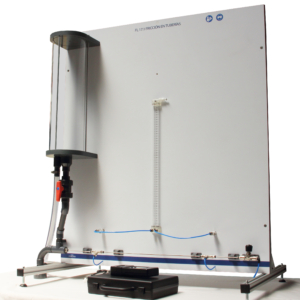FL 28.1 – Pascal Apparatus
Equipment designed for the study and demonstration of Pascal’s law.
Description
Equipment designed for the study and demonstration of Pascal’s law.
This law was enunciated by the physicist and mathematician Blaise Pascal (1623-1662) and says that “The pressure exerted on a point of a fluid in equilibrium is transmitted in full in all senses.”
Also with this equipment we can study the called “hydrostatic paradox”, which is a consequence of Pascal’s Law “The pressure inside a liquid at rest depends only on the height of water, regardless of the amount”.
There are numerous applications based on Pascal’s law, one of the best known is the hydraulic press.
Learning Objectives
- Study and demonstration of Pascal’s Law.
Technical Data
Set of glasses
- Maximum depth in glasses = 228 mm
- Parallel glass
- Ø26 mm
- Conical glass A
- Øsuperior = 101 mm
- Øinferior = 26 mm
- Conical glass B
- Øsuperior = 9 mm
- Øinferior = 26 mm
Membrane
- Ømembrane= 56 mm
Requirements
–









